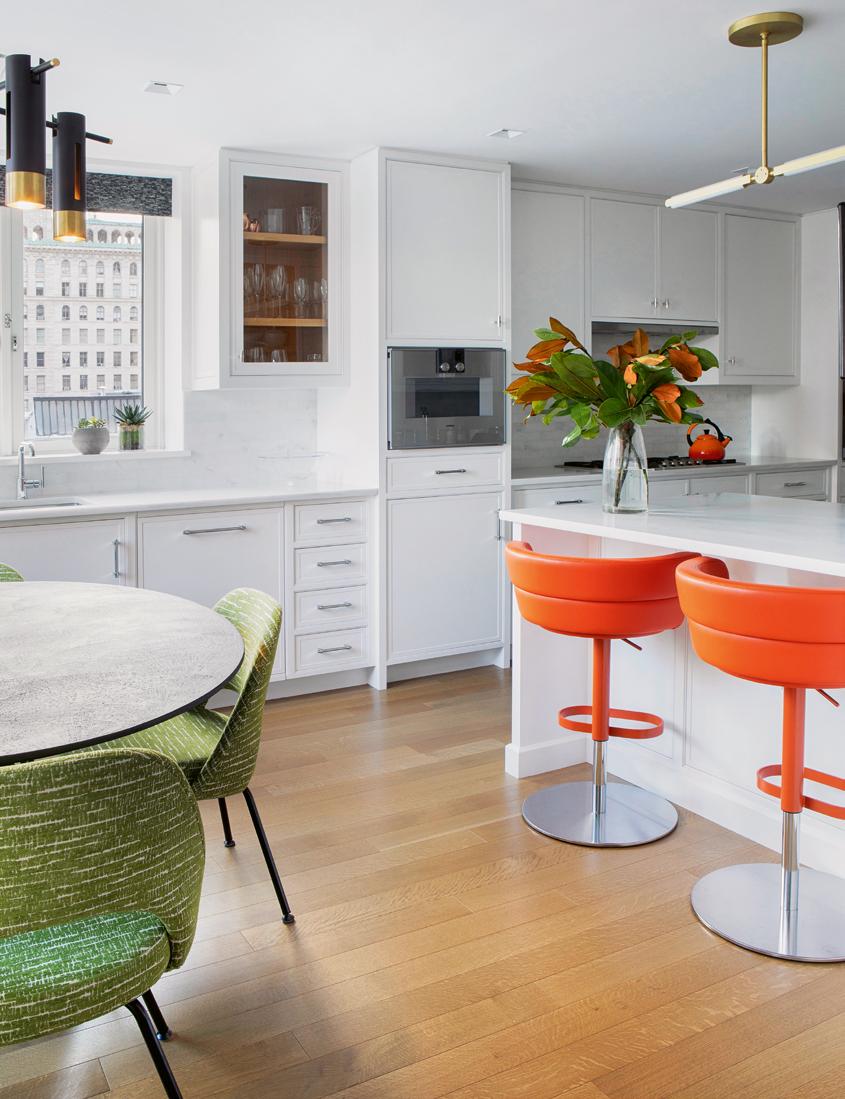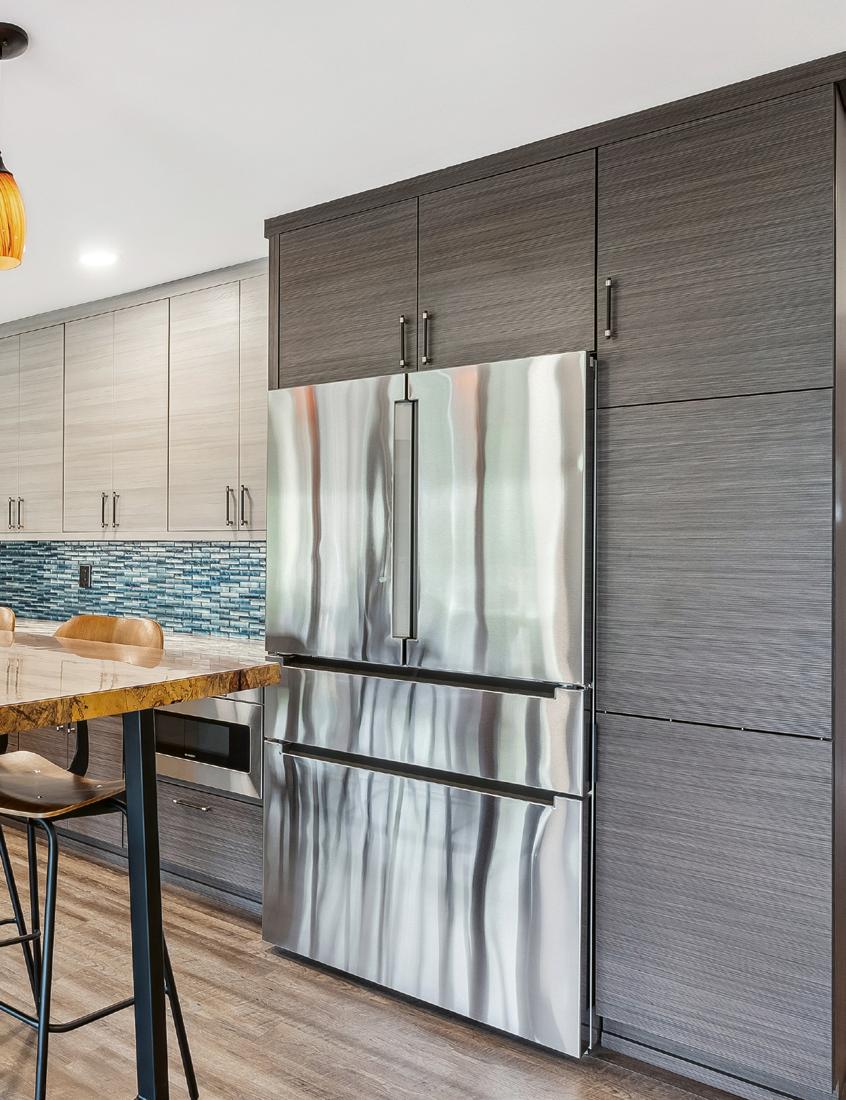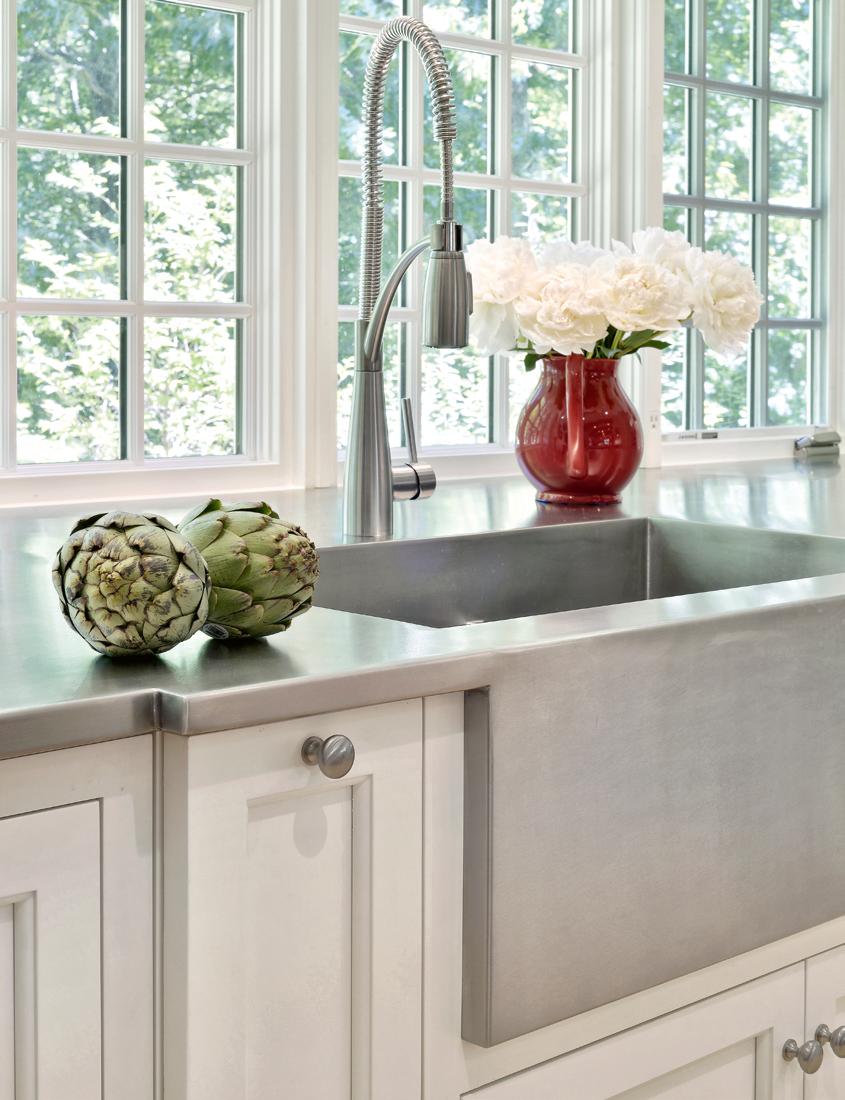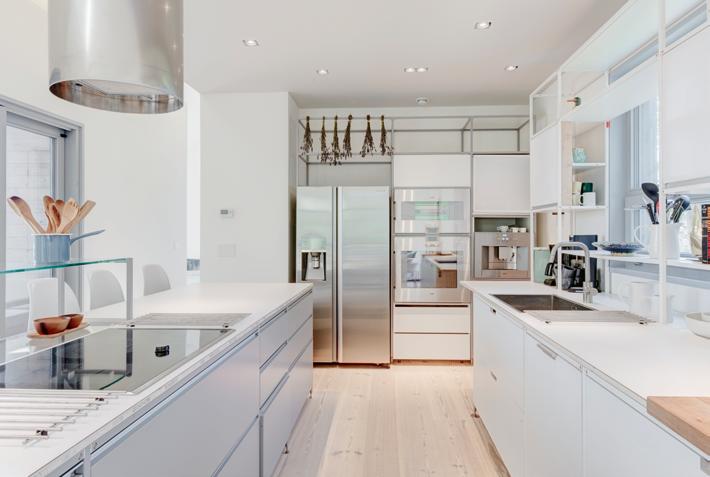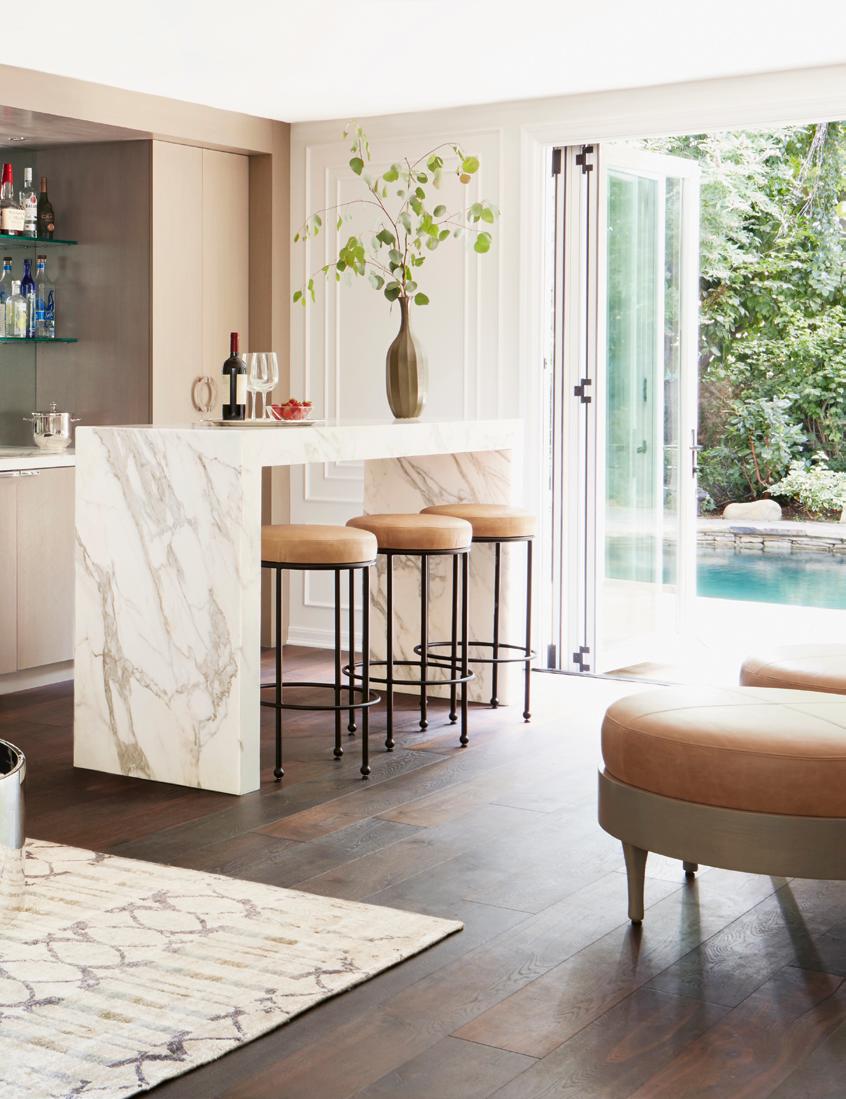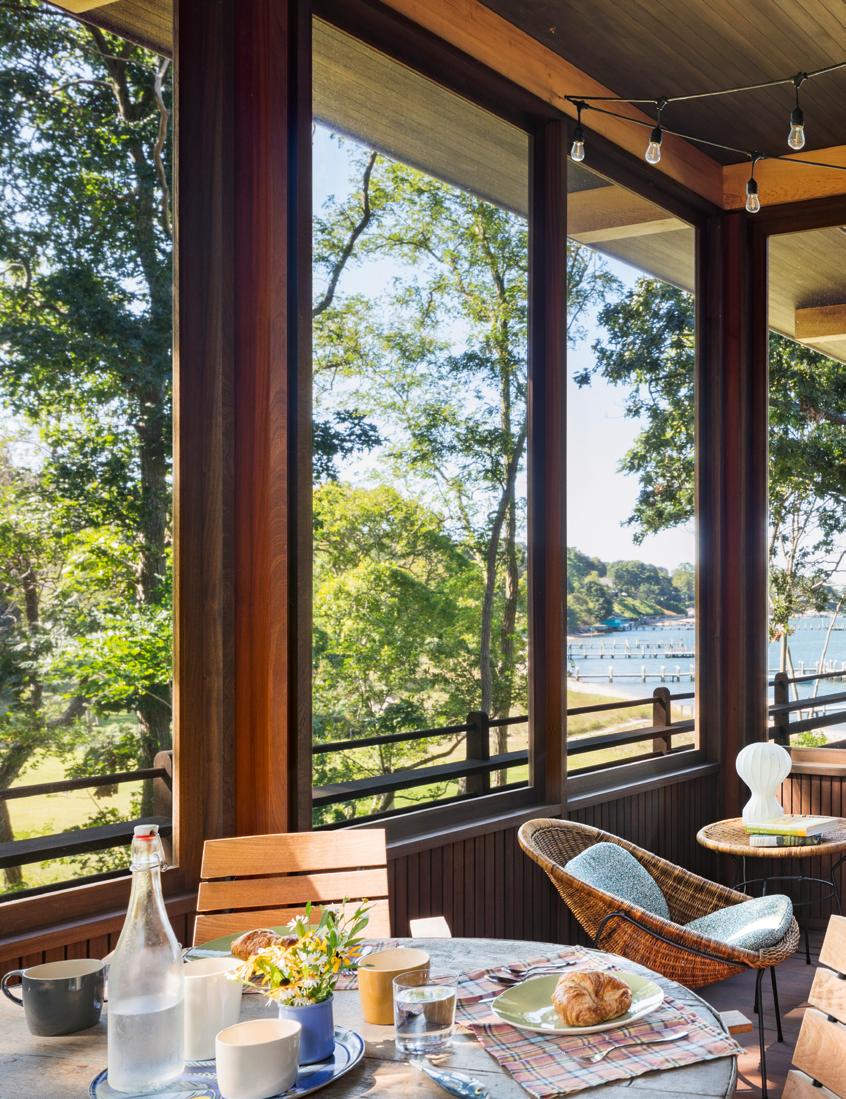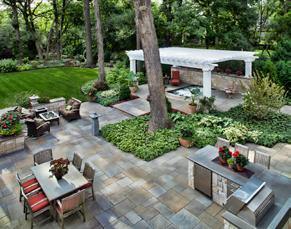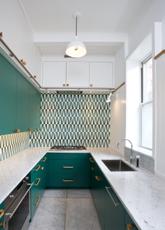Barbara Ballinger ◆ Margaret Crane
A cozy nook in this elegant kitchen, by Ashley Sharpe in collaboration with Bilotta Kitchen & Home, includes a built-in desk. Kitchen desks, or work nooks, are making a comeback, often tucked away in a corner or non-traffic zone for privacy.
6 FOREWORD
Dr Jessica Lautz
10 INTRODUCTION
Barbara Ballinger & Margaret Crane
NUTS & BOLTS 15 CHAPTER 1
Inside & Outside the Boxes: Cabinets, Shelves, & More
41 CHAPTER 2
Surfaces: Countertops, Floors, & Backsplashes
63 CHAPTER 3
Appliances: Your Essential Helpers
85 CHAPTER 4
Twists & Turns in Tapware: Faucets, Handles, Hardware, & Hinges
101 CHAPTER 5
Islands: Centerpieces of Today’s Kitchens
119 CHAPTER 6
Think (in) Color
137 CHAPTER 7
Lighting: Illuminating Your Kitchen, Indoors & Outdoors
153 CHAPTER 8
The Kitchens of Tomorrow
183 CHAPTER 9
Auxiliary Spaces
199 CHAPTER 10
Outdoor Kitchens
DESIGN CONSIDERATIONS
BLUEPRINT
211 CHAPTER 11
In Conversation with the Pros: Five Design FAQs
221 CHAPTER 12
Budget Remodels & Facelifts
227 CHAPTER 13
Universal Design Kitchens
235 CHAPTER 14
How Resale Factors Influence Kitchen Design
239 CHAPTER 15
Second-home Kitchens: Eat, Cook, Unwind
248 CHAPTER 16
The Process & Who Does What
257 CHAPTER 17
Teamwork: All Together Now
RESOURCES
264 Credits & Resources
269 Photographer Credits
270 Acknowledgments
272 About the Authors
Opposite Smallbone kitchen cabinetry is repainted to appear more like lacquer in this kitchen by director of interior design, Jessica Shaw, from The Turett Collaborative: Architects & Interior Designers.
Inside & Outside the Boxes: Cabinets, Shelves, & More
Selecting cabinets is a complicated process, and one of the most significant decisions a homeowner can make when remodeling or building a kitchen.
Begin by looking at your budget. Cabinets represent the largest investment in the kitchen, but there are so many other related decisions to be made as part of the cabinet selection process. For example: what size/s do you need? What style of door fronts do you like? Do you want closed cabinets, open shelving, or framed glass doors? What type of material appeals to you, and what will work with the style of your home? You might love teak because it’s the epitome of sustainability, but it doesn’t come cheap. There are other sustainable options, however. So, back to the drawing board. What about color? Can you mix and match hues on the perimeter and island, if you have room for that feature?
Cabinet selection basically boils down to this: what you decide becomes a balancing act between budget, space, function, and aesthetics. If you’re improving on an existing kitchen, there’s also the cost of removing the old cabinets that adds to the overall budget for installing new cabinets. It’s not the cost of the cabinets alone to consider.
Besides cost, function should rank high on your list. Most of us have accumulated stuff through the years to keep within the cabinets—or boxes, the industry term. You may want to put items within closed cabinets with solid doors, hidden away like a secret agenda. Open shelves (in a material that contrasts with the cabinets) above countertops in the main kitchen is a desired look to give the kitchen a modern, updated aesthetic. You may also want to store items that don’t need to be seen or aren’t used daily in the walkin pantry, known under a number of other names such as “dirty kitchen” or “scullery.” The key is to put away what you don’t use frequently rather than crowd counters, where you want unobstructed places to work.
Next, when deciding on the cabinetry’s construction, consider its design— door style, material, finish, color, and hardware, hinges and pulls. This is no easy task because, once again, there are so many options and huge price ranges within each category.
FiVe extra tips to achie Ve a coordiNated look from designers Jodi Swartz and Suzan Wemlinger
▶ Bring home samples. “It’s important to have samples of all the different surfaces when making final selections—don’t just work from photos. Have several samples of each surface so you can see the variations in each tile/plank, which are likely to occur. For countertops, it’s important, particularly with natural stone, to view the actual slabs that will be used in your home. There is so much variation in pattern flow, as well as different shades of the same color. This will help you coordinate patterns and colors,” advises Wemlinger.
▶ Mix and match. “Feel free to mix larger patterns with smaller ones. Solid counters with veined ones,” Swartz says.
▶ Choose an inspiration color for the kitchen or dining spaces. Add it to the backsplash. “I am a fan of color in splashes and hardware; they are easier to trade out in a couple of years,” Swartz says.
▶ Start with one area. “How one homeowner or designer starts choosing selections varies from person to person, or project to project. If you find a backsplash tile you love, use that as the jumping-off point and make it the star of the show. The countertops can then be more subtle or low key, so they don’t take away from the tile,” Wemlinger says.
▶ Too many stars spoil the show. “If you’ve been saving photos of kitchens with amazing countertops, however, start with that instead. In this instance, make sure the backsplash is the little sister to the countertop—more subtle. It doesn’t need to be plain or boring, just not the showstopper that the countertops are. It’s also important that the patterns are not too similar. If the countertop has a dramatic flow through it as mentioned, the tile can be a soft wash of color with subtle variations, or it can be a solid color or neutral,” Wemlinger says.
Right Andrew Franz Architect combines simple materials with countertops of statuary marble from ABC Stone, a backsplash of Komon terracotta tiles by Made a Mano, a solid reclaimed rift red oak floor, and open shelves.
Opposite A farmhousestyle sink fabricated in stainless steel continues as a countertop along the perimeter under the windows. Designed by Jeff Eakley, Bilotta Kitchen & Home, with Carol Kurth Architecture + Interiors and Legacy Construction
Twists & Turns in Tapware: Faucets, Handles, Hardware, & Hinges
Not too long ago, tapware was an afterthought, a bit player with utilitarian functions. Today, tapware has become more of a star. Its time has come as a kitchen focal point with style, statement, and greater purpose.
Why now? “Designers are always searching for the next cool item to go in a kitchen,” says certified kitchen designer (CKD) Eric Goranson, host of podcast and radio show Around the House, interior designer, DIY expert, and construction educator in Portland, Oregon. Tapware still serves an important function, but today it can be a finishing touch to enhance the overall design or even be the main attraction in a kitchen plan. One great faucet at the main kitchen sink can add color or a sculptural look that’s unexpected.
Tapware comes in a wide range of finishes, styles, shapes, and sizes and is everywhere in big-box stores, plumbing supply wholesale houses; kitchen design shops and showrooms; and even online. There are thousands of choices in a wide range of prices—from readymade and off the shelf to made-to-order pieces resembling sculptural works of art.
The different price levels reflect how the product is manufactured, its materials, and labor involved. And even at the lower to mid-range price points, there is a lot of bang for the buck. For instance, in mid-grade tapware, fashion designers such as Jason Wu (whose name became widespread when he designed an inaugural gown for former First Lady Michelle Obama) are putting their names on new collections.
what’s treNdiNg?
Mixing materials
It’s 100 percent acceptable to mix materials—types and colors. Think modern bars and traditional knobs, mixing silver and gold, or adding a pop of color. Molly Switzer, associate kitchen and bathroom designer (AKBD), principal designer, and owner of Molly N Switzer Designs, LLC, in Portland, Oregon, says this is one of her favorite aspects of current trends. “The mix of finishes on a particular piece is helping to make it more of a standout and unique piece rather than just another brushed nickel fixture in the mix,” she says.



But for those who want to put technology front and center in their kitchens, a sleek, contemporary design might one day resemble a spaceship, with angles and curves of cabinets and islands not unlike the exterior of Walt Disney Concert Hall in Los Angeles, designed by Canadian American architect Frank Gehry. Futuristic ideas in kitchen design abound. Rush saw many when he closely followed the building of the House of the Retro Future at the Howard Johnson Anaheim Hotel and Water Playground, designed in 2022 in Anaheim, California. It was heavily influenced by the Monsanto House of the Future, featured in Tomorrowland at Disneyland Park that closed in 1967. Rush says there are round islands with suspended hoods so someone could cook and see from any angle in the home. There is lighting that turns on automatically on the breakfast side of the kitchen and, in the evening, on the dinner side. “It is like harnessing the environment in a thoughtful way to bring it fully into your home,” Rush says.
Other futuristic features might include integrated cabinets, those in unstandardized sizes, and ones that might stretch from ceiling to floor. Islands could be serpentine in shape and range hoods may look like lighting fixtures, integrated architectural elements, or a submarine periscope to create a nautical aesthetic. When it comes to melding automation with sustainability and other homeowner design choices, the possibilities are limitless.
This spread This kitchen, in a house with architecture and interiors designed by The Turett Collaborative: Architects and Interior Designers, follows Passive House standards with such elements as an induction cooktop and wood and metal cabinets.
sustaiNability
As the demand for technology heats up—much like the planet—we have entered an age of sustainability. Likely options in future kitchen design are all-electric kitchens and appliances (some smart) that use less energy, lower our carbon footprint, and may even include solar- and wind-powered technologies that are likely to steamroll fossil-fuel equivalents at some point.
The concept of sustainability might not roll off the tongue yet for everyone, but its time has come, with so many choices percolating now. Architect Nathan Kipnis, based in Evanston, Illinois, and Boulder, Colorado, is a proponent of sustainable and high-performance homes and kitchens. Kipnis says, “We want not only our designs to be extremely high performance, healthier, more efficient both in their operational carbon (HVAC system, lighting, refrigeration, and so on) as well as their ‘embodied carbon,’ which is the carbon needed to extract, transport, process, and install the actual materials, but to be beautiful as well.”
This cultural shift is happening for a reason. In part, the increased interest in sustainability is an aftermath of the pandemic. It made us hyperfocused on our environment, health, and cleanliness with our gallons of hand sanitizer, incessant hand washing, and scrubbing everything down, including our groceries and mail. Special air purifiers and ventilation systems gained popularity in a slow transformation to cleanse the air of germs and toxic fumes in our homes and especially our kitchens, where we gather the most.
siNk
Having a sink requires extra planning if you want hot and cold water since it will need to be connected to your sewer line and winterized with antifreeze. “In the Northeast, it gets complicated,” Nissim says. In worst cases, it might not be used that much for cleaning dishes and glasses but could offer a place to serve as a big ice bucket or present some seafood on ice for guests.
piZZ a oVeN
It sounds great to be able to grill your own at home, and some companies like Kalamazoo and Alfresco make sophisticated models that work by natural gas and fire up the heat to replicate the taste and texture of a wood commercial design for pizza pies. These sit on a countertop. Not surprisingly, these models are expensive. Even pricier is building a freestanding masonry or stone fireplace and having a pizza oven incorporated. Think $25,000 or more. Glassman and his wife prepare great pizza on their barbecue with a pizza steel. “We do so every Friday night and make the dough and sauce. It’s restaurant quality,” he says. Ooni Koda also manufactures a 12-inch, gas-powered pizza oven that’s a few hundred dollars and can sit on a countertop.
Above Drawing inspiration from the architectural era of the house and exotic journeys travelers took, the Adeeni Design Group commissioned bespoke Moroccan brass lanterns to illuminate the counters of the stone pizza oven. The space is also adorned with elegant blue and white Chinese pottery. Following pages Nestled in the bustling heart of downtown Denver, Colorado, this mission-inspired custom home and landscape conjure an enchanting and cozy atmosphere with old-world charm, designed by Abby Rupsa, principal landscape designer/owner, Botanical Living.
trash ceNter
It’s so easy to forget to include trash cans but so useful to make room for one. Few people want to lug the indoor trash cans outside for each meal, especially for large gatherings. Keep rubbish bins concealed if you can by tucking them under a counter, suggests Nissim. And be sure there’s a sturdy cover so animals of all kinds do not help themselves to your leftovers.
built-iN desigNs
If you’re having more than a freestanding barbecue or grill, it’s worth considering built-in components in a storage unit to gain counter and storage space in the form of drawers or cabinets. The look is neat and keeps all of your accessories together. Most often, the structure is built from stones or brick with a facing of stone, brick, or wood.
A good countertop that will withstand the cold is granite. Nissim favors a leather textured style, which doesn’t require staining. Glassman also likes poured concrete but says it requires staining and sealing. He advises avoiding synthetic materials that may separate in the heat. For this feature, he suggests going longer than expected—at least eight feet and with three or four feet or so for counters on either side of a grill to cook and later to serve. He also prefers arranging the counters in an L or U shape so the cook can face diners rather than have their back to guests. And he likes to leave a hole in the counter and insert a metal sleeve to install an umbrella to shield from heat and rain or even snow! Nearby, he may have a separate bar with cantilevered edge with stools for sitting and/or a pergola or other open-air structure where diners can sit and be partially protected. These types of features should be left either fully or partially open above so air can circulate and keep smoke out.
lightiNg
Lighting is key for night-time use, preferably with LED bulbs, which last longer, are more energy efficient, and can be programmed automatically. You may also want to add colorful bistro-style or rope lights for a festive, party mood, even if it’s just one or two people enjoying food prepared and eaten outdoors!
heat
If there’s a structure overhead like a pergola, you can hang radiant heating bars. Drop them down like a pendant. Or you can do an outdoor radiant floor if you have tile or porcelain.
FaN
“Some homeowners also find a fan useful to keep air circulating, which also can help with bug control,” says Glassman. They are guests who are not welcome!
Now more than ever, the kitchen continues to be the epicentre of the home. To serve its multiple purposes, the design must be functional, comfortable, and chic. Enter Kitchen Conversations: the friend you want in your corner. Whether you are working on a budget, sparing no expense, or trying to find a nice balance, this book will guide you to make crucial decisions on details large and small, and be your companion on the journey of imagining, planning, designing, and then building the kitchen of your dreams. There may be challenges along the way but being aware of what lies ahead will allow you to manage them well.
While feasting on full-color photography and real kitchen plans, you can also savor the input from kitchen designers and other industry professionals; personal stories of kitchen builds, remodels, and cosmetic changes from many homeowners; useful information from homeowners and industry sources, and valuable tips for managing contractors throughout the entire process.
Front cover image : A 1905 historic craftsman bungalow in downtown Napa, California, features a
functional and modern classic kitchen that respects the home’s traditional roots. Architectural interior design by Lori Gilder, Interior Makeovers Inc., and Rebecca Reynolds, Rebecca Reynolds Design | Photography by Michelle Drewes, Michelle Drewes Media



